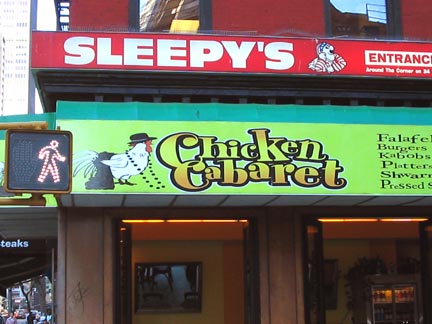
One day, I imagine we’ll need a museum to house all the art imitating or inspired by Empire, Andy Warhol’s 1965 eight-hour stationary-shot film of the Empire State Building. And I imagine that’s a good thing. It’s probably also the easiest work around to imitate (and therefore hardest to do well).

I’m thinking particularly of two recent works. There’s Douglas Gordon’s Bootleg (Empire) from 1998, which begins as a filming of an Empire screening in Berlin but then apparently then takes an intermission at a local bar.

Earlier this year Reena Spaulings and Co. filmed Imperio, a static shot of the Empire-State-Buildingesque Torre Latinoamerica in Mexico City—which saves itself as an idea if viewed through Mexico City’s rise as an international contemporary art center to one day rival New York.
(Loosening our criteria, we could stretch out to find Empire’s presence in far-afield works like Cremaster 3 [epic-length, skyscraper envy, oedipal rage] and the “i am not here and this is not happening” window scene in Grant Gee’s Meeting People is Easy: A Film about Radiohead [stoner fascination with the cityscape].)
So, predictably enough, here’s my idiot proposal:

Model Empire
The R.J. Reynolds Tower in Winston-Salem, North Carolina, is a prototype of the Empire State Building constructed in 1929 by ESB architects Shreve Lamb and Harmon as a one-third scale model to test the viability of their proposed tallest building in the world in New York. It was and is owned and operated by the tobacco company, and held the record of tallest building in North Carolina for close to 40 years.
Considering the strange logic that calls for, or at least accepts, a continued grappling with Warhol’s tenacious relevance, the Reynolds Building could withstand being filmed as a posthumous maquette for the artist’s finished masterpiece. We should totally do this as soon as I can scrape a camera and a car together for the road trip. We could grab some BBQ and maybe make a pit stop at Wrightsville Beach. I’m not sure yet which would be the more rigorous: should Model Empire be 1/3 the length of the original, run time appx. 2:40, to match the Carolina building’s 3:1 scale to the New York one? Or does it need to be three times as long (24 hours) so that at the end we’ve captured the same amount of building? But who would screen that?
The National: Fake Empire mp3







